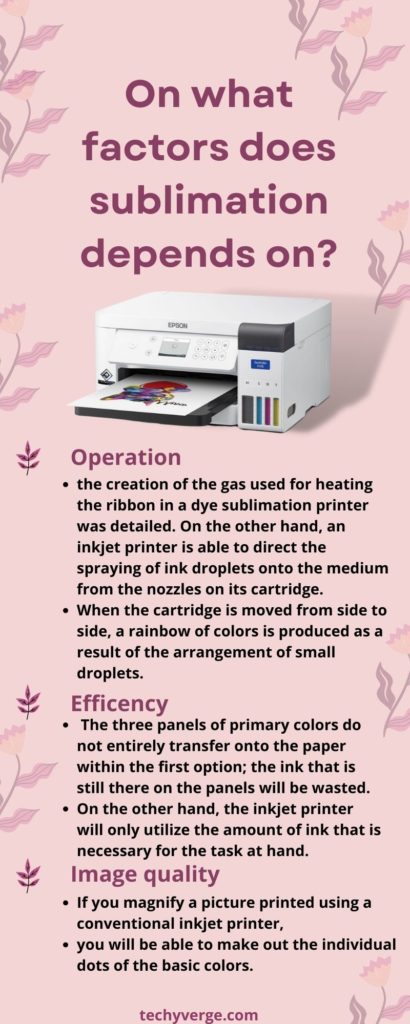Sublimation is a remarkable process that transforms a substance directly from its solid state into a gas, bypassing the liquid phase altogether.
This unique phenomenon has significant implications across various fields, including chemistry, materials science, and engineering. Let’s explore the fascinating world of sublimation and its diverse applications.
- Sublimation is the process where a substance transitions from a solid to a gas without becoming a liquid.
- It finds applications in chemistry, materials science, and engineering.
- Sublimation is widely used in the production of carbon fiber, semiconductor devices, and optical fibers.
- It also offers a creative avenue for producing intricate patterns and designs on materials like fabric and glass.
- The precise control over the direction of the gas produced during sublimation enables its use for decorative purposes.
- Furthermore, sublimation can be utilized to preserve various objects by removing all the moisture, thereby preventing deterioration.
- Items such as flowers, documents, and insects can be effectively preserved using sublimation.
- With its diverse applications and potential for future advancements, sublimation continues to captivate researchers and innovators alike.
What Exactly is Meant by “Dye-Sublimation Printer”?
The analogy of a conventional inkjet printer may help understand a dye-sublimation printer. The following are three ways in which the process and capabilities of a dye sublimation machine are distinct from those of a conventional inkjet printer:
Operation
In the previous section, the creation of the gas used for heating the ribbon in a dye sublimation printer was detailed. On the other hand, an inkjet printer can direct the spraying of ink droplets onto the medium from the nozzles on its cartridge.
When the cartridge is moved from side to side, a rainbow of colors is produced due to the arrangement of small droplets.
Efficiency
The productivity of a printer that uses dye sublimates is not nearly as amazing as the productivity of an inkjet printer.
The three panels of primary colors do not entirely transfer onto the paper within the first option; the ink that is still there on the panels will be wasted.
On the other hand, the inkjet printer will only utilize the amount of ink that is necessary for the task at hand.
Quality of the Image
In this respect, dye sublimation is superior. Dye sublimation is more analogous to the film industry, whereas inkjet printing is more analogous to the video industry.
The first method generates a picture with a color spectrum that is continuously mixed, providing an effect comparable to that of conventional photography.
If you magnify a picture printed using a conventional inkjet printer, you can make out the individual dots of the basic colors. It is comparable to a highly detailed picture created on a computer.
What Exactly is Sublimation Dye ink, though?
Printing on novelty products like coasters, t-shirts, plaques, and mugs is accomplished with a special kind of ink called dye sublimation ink, in addition to high levels of pressure and heat. This kind of ink offers several major advantages, including the following:
- It has a longer shelf life compared to conventional inks. You will not see the picture fading or peeling away from the printed product.
- The dye sublimation ink is resistant to water.
- The high heat and coating almost eliminate the possibility of smearing.
- Considering the precision of vaporization over standard inkjet droplets), the precision is very high (especially when compared to standard inkjet droplets).
Recent addition: What is a self-healing mat?
Dye Sublimation Printing Materials: What Can Be Used?
These printers are not designed to function with common office supplies like printer paper, labels, or envelopes. Rather, they are widely used for printing onto various novelty products such as coffee mugs, t-shirts, and other items.
Rubber, synthetic cloth, or plastic must be used to produce the substrate. Cotton and other natural fibers are not suitable for this technology since it does not perform well with them.
Gaseous ink does not form bonds with natural fibers in the same way. As well as it does with synthetic fibers; rather, it travels unimpeded through natural fabrics.
Examples of media with the requisite elements for dye sublimation printing include shower curtains, bathing suits, mouse pads, floor mats, coasters, flip-flops, event wristbands, and sportswear.
Dye-sublimation printing may also be used on swimming suits. In addition to these more general usages for promotional purposes, the machines may also be used to generate picture prints or postcards by using specifically coated media, such as cards or paper.
What is the Process Behind a Dye Sublimates Printer, and How Does It Work?
Again, what exactly is dye sublimation? While the material presented so far makes it possible to have a better knowledge of the fundamentals, let’s go a little more into the concept of transfer paper.
Transfer paper is the most frequent medium for usage in conjunction with these printers. However, printing directly onto the fabric is also an option. The procedure will be more difficult if you want to print using a transfer method.
When you develop projects using a transfer method using a dye-sublimation printer, you can:
- The transfer paper will have ink dried out and applied to it.
- This is when the paper is put through a heat press.
- The solid ink transforms into a gas due to the process of sublimation.
- When the gas penetrates the fibers of the synthetic material or the plastic substance, an extraordinary picture begins to take shape.
Compared to a dye-sublimation printer, a conventional inkjet printer is much easier to understand (see the above section).
In the first method, the liquid ink inside the cartridges eventually dries into a solid state on the paper’s surface due to the interaction of heat and air.
Dye-sublimation printers use liquid ink, which dries and becomes solid after it is introduced to a medium. The next stage is the vaporization of the solid ink, referred to as “sublimation” in this context.
What is the difference between dye sublimation and sublimation?
It is often assumed that “sublimation” and “dye-sublimation” refer to the same process, but they are two different methods. A solid is transformed into a gas through sublimates without passing through a liquid state.
In a dye sublimation printing technique, dye is vaporized onto a material through the heat to transfer the dye from the dye carrier to the target material.
So, while the two terms are related, they are not the same thing. If you’re looking for more information on either process, use the correct term to ensure you get the necessary information.
On What Factor Do Sublimates Depend?

Conclusion:
In conclusion, sublimation is a captivating process that defies traditional state changes. Its ability to transform solids into gases without transitioning through a liquid phase has broad implications in chemistry, materials science, and engineering.
From the production of carbon fiber to the preservation of delicate objects, sublimation showcases its versatility. As we delve deeper into this phenomenon, we can expect to uncover even more exciting applications in the future. Sublimation truly represents the powerful convergence of science and creativity, with endless possibilities waiting to be explored.
Sublimation is a process where a substance transforms directly from its solid state into a gas without passing through the liquid phase.
While evaporation involves the transition of a liquid into a gas, sublimation skips the liquid phase and converts a solid directly into a gas.
Common examples of sublimation include dry ice (solid carbon dioxide) changing into a gas without melting, mothballs gradually disappearing, and snow disappearing without melting into water.
Sublimation plays a crucial role in various industries. It is used in the production of carbon fiber, manufacturing semiconductor devices, preserving delicate objects like flowers, documents, and insects, and creating intricate designs on materials like fabric and glass.
Yes, sublimation can be reversed through a process called deposition. Deposition involves the conversion of a gas directly into a solid without going through the liquid phase.
While sublimation itself is a natural process, certain substances may release harmful gases during sublimation. It is important to handle such substances in well-ventilated areas and follow safety guidelines to avoid any potential risks.
- Can You Sublimate on Nylon and Polyester? Which oneis the Best - February 19, 2024
- Converted Epson Eco Tank Et-2800 Vs Et-2803 Sublimation Printer [Review 2024] - February 19, 2024
- Can You Reuse Sublimation Prints? (The Righ Answer) - February 19, 2024



![Top 100+ FAQs Related to Sublimation Printing & Heat Press [Updated 2024] faqs related to sublimation Printing](https://www.techyverge.com/wp-content/uploads/2022/08/faqs-related-to-sublimation-Printing--150x150.jpg)


